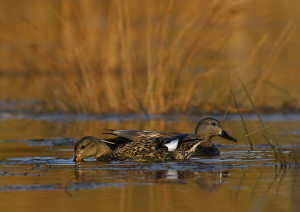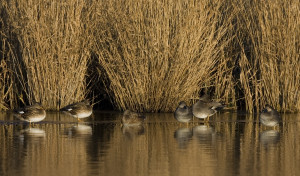 Gadwall or gray ducks, provide a love/hate relationship for many hunters. In recent years, the population of gadwalls has increased, providing hunters across the country with more and more gray duck hunting opportunities. However, the behavior of the gray duck is unlike that of virtually any other waterfowl, so it can both confuse and frustrate anyone new to the species.
Gadwall or gray ducks, provide a love/hate relationship for many hunters. In recent years, the population of gadwalls has increased, providing hunters across the country with more and more gray duck hunting opportunities. However, the behavior of the gray duck is unlike that of virtually any other waterfowl, so it can both confuse and frustrate anyone new to the species.
Gray Ducks Have Unpredictable Behavior
One of the keys to success for any duck hunter is to figure out the behavior of the ducks in any given area. In normal hunting situations, the birds will come to an area that is rich in food until given a reason to stay away. Obviously, in most cases, that means they are coming under fire every time they approach a given feeding zone.
Gray ducks, however, seemingly change their behavior for no apparent reason. They can come into a fresh zone and mingle with the decoys one day and then the next day completely avoid them in an abundant and new feeding area. Just when you think you have them figured out, they do something completely different and have you shaking your head and going home with an empty bag.
Watch the Behavior of the Early Arriving Gadwalls
In general, the early birds will tell the story of how the birds are feeling that day. For instance, if the first couple of groups hit the decoys hard, you can be fairly positive the rest of the approaching birds will do the same. If, however, the early arriving gadwalls circle and then fly away, the group may be spooked for some reason and you will have to adjust your strategy to get them to approach your area.
Adjusting Your Hunting Strategy for Gray Ducks
You are probably going to have to adjust almost every aspect of your favorite duck hunting techniques at some point if you are going to get your quota of gadwalls. From the spread to the call, you may have to make some adjustments on the fly to avoid going home empty handed.
Calling Gadwalls – the call of a gray hen call is similar to the call of a mallard hen, but there are differences. The most notable is the “nasal-like” tone of the gray versus the mallard hen. Most expert callers will suggest that you speed the cadence of your call to attract the birds. It is also important to note that gadwalls do not have a naturally loud call, so you may want to use a standard mallard call if the birds are far away just to get their attention. Once the birds are interested, switch over to the drake gadwall call.
These birds being what they are, the call itself is sometimes enough to scare them off. If this is the case, simply stop calling to see how the birds react. If your spread is able to get their attention, you may want to avoid calling for a bit to see how it goes.
Gadwall Spreads – there are several schools of thought, here, but how you create your spread will probably be more budget-oriented than anything else. Ideally, you should be using a fairly large number of gadwall decoys when hunting gray ducks. If you cannot afford to do this, you can use your mallard decoys they will readily decoy to mallard decoys.
 As with most waterfowl, big numbers means safety. That being said, you should arrange your spread in a bunch of smaller groups, creating landing zones for the gadwalls when they arrive. Smaller blocks of no more than eight decoys is ideal. You may also want to consider adding a few other decoys to the spread to elicit a bit more confidence in the birds. Coot decoys are an option because grays will sometimes trail coots and take their leftovers as they feed. Having a few of these will give a “safe” appearance to the gadwalls when flying over and give them a bit more confidence they can land safely and hit the buffet. Spinning wing decoys are attractive to Gadwall ducks like most waterfowl and are deadly early and become less effective as the day and season progresses.
As with most waterfowl, big numbers means safety. That being said, you should arrange your spread in a bunch of smaller groups, creating landing zones for the gadwalls when they arrive. Smaller blocks of no more than eight decoys is ideal. You may also want to consider adding a few other decoys to the spread to elicit a bit more confidence in the birds. Coot decoys are an option because grays will sometimes trail coots and take their leftovers as they feed. Having a few of these will give a “safe” appearance to the gadwalls when flying over and give them a bit more confidence they can land safely and hit the buffet. Spinning wing decoys are attractive to Gadwall ducks like most waterfowl and are deadly early and become less effective as the day and season progresses.
Patience and observation are two skills you are going to have to master if you want to be a successful gray duck hunter. Scouting these birds is completely different from most other waterfowl. Because the behavior can change drastically from day to day, your scouting sessions need to be conducted early in the day instead of coming out a day or two early, as some hunters will do for mallards.
You will spend a good part of your morning driving around to different areas to see which areas are hot feeding zones for the birds on any given day. Once you find the hot zones where the birds are dropping in, you need to remain focused on how they are reacting to specific spreads and calls to ensure you are using the right techniques to match up with the whims of the gadwalls on that particular day.






